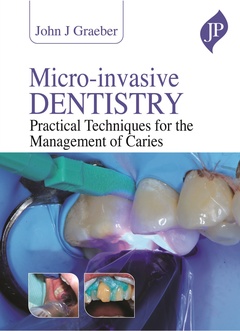Description
Microinvasive Dentistry
Clinical Strategies and Tools
Author: Graeber John J
Language: English
Subjects for Microinvasive Dentistry:
Approximative price 109.06 €
In Print (Delivery period: 14 days).
Add to cart212 p. · 17.1x24.1 cm · Hardback
Description
/li>Contents
/li>Biography
/li>
Tooth decay, also known as dental caries or cavities, is a breakdown of teeth due to acids made by bacteria. The cavities may be a number of different colours from yellow to black. Symptoms may include pain and difficulty with eating.
Microinvasive techniques involve preparing the tooth surface with an acid and then either placing a seal on top of the surface or 'infiltrating' the softer demineralised tissue with resins. These newer methods work by installing a barrier either on the tooth surface or within the demineralised tissue to protect it against acids and avoid the further loss of minerals from within the tooth, thus helping to stop the decay.
This book is a comprehensive guide to techniques, technologies and tools used in microinvasive dentistry.
Divided into four sections, the text begins with an overview of caries and its prevention. The following sections provide in depth discussion on diagnosis through various imaging devices, then different treatment options and technologies. The final section covers future developments including enamel regeneration and photobiomodulation.
Authored by an internationally recognised, New Jersey-based expert in the field, the book is further enhanced by clinical photographs, diagrams and tables.
Key points
- Comprehensive guide to microinvasive techniques and technologies for diagnosis and management of dental caries
- Covers diagnostic imaging devices and numerous treatment options
- Authored by highly experienced, New Jersey-based expert in the field
- Includes clinical photographs, diagrams and tables
Section I: Caries prevention
- Introduction
- Prevention: fluoride & enamel regeneration
- Caries-penetrating resin therapy
- Identifying patients at risk of caries
Section II: Diagnosis
- Intraoral video cameras
- Near infrared transillumination
- Canary System
Section III: Treatment options and technique
- SoproLife® dental caries detection system
- Laser fluorescence caries diagnostic device: Diagnodent
- The Surgical microscope for diagnosis and treatment of caries
- Conventional diagnostic failures
- Microbiological aspects of caries treatment
- Air abrasion: background and cavity preparation
- Air abrasion: technique
- Erbium Lasers
- CO2 lasers (9300 nm)
- Dentin regeneration
- Ozone therapy
- Conventional treatment failures
Section IV: Future caries diagnosis and management
- Enamel regeneration
- Photobiomodulation
John J Graeber DMD MAGD MALD FICD
Co Founder, Past President, Academy of Laser Dentistry, Private Practice, New Jersey, USA
These books may interest you

Essentials of Dental Caries 53.50 €

Pathology of the Hard Dental Tissues 161.06 €


